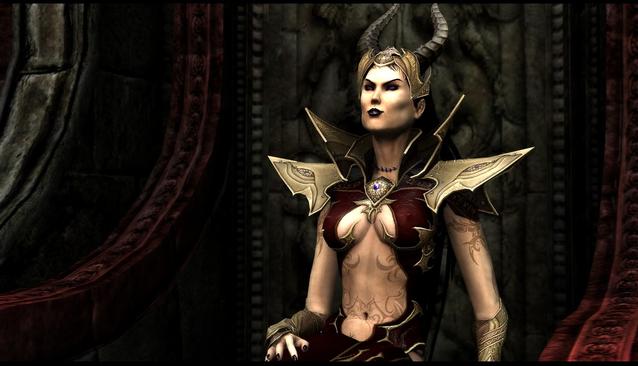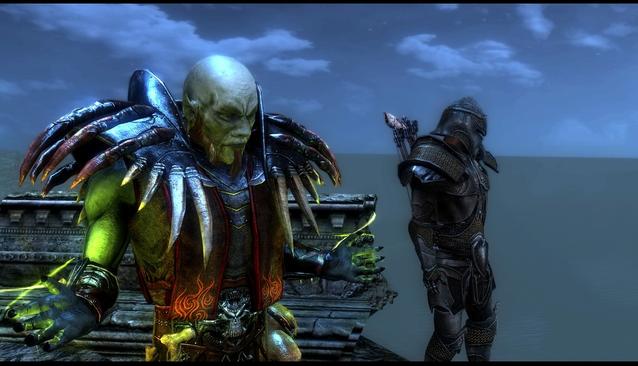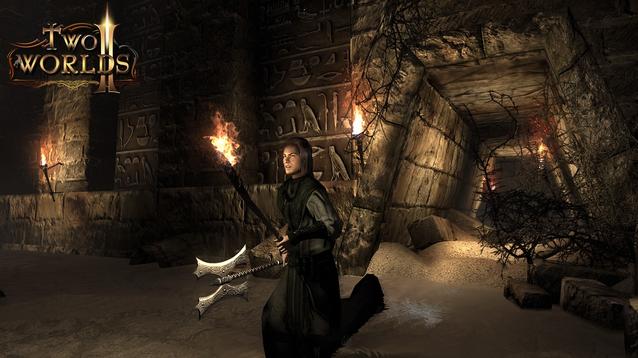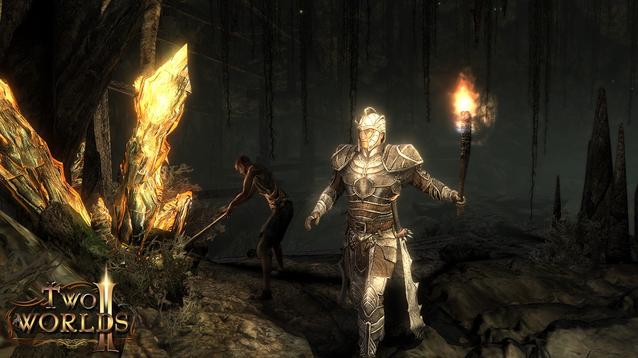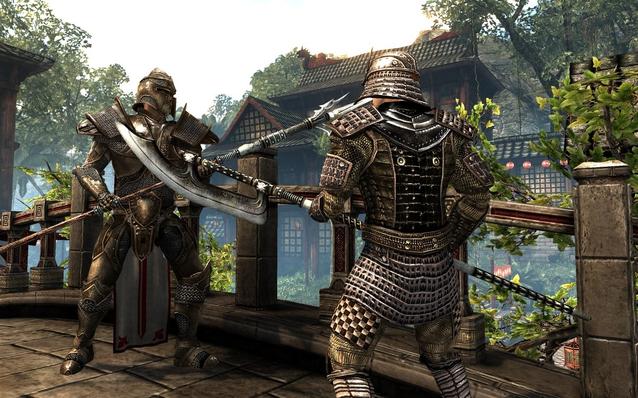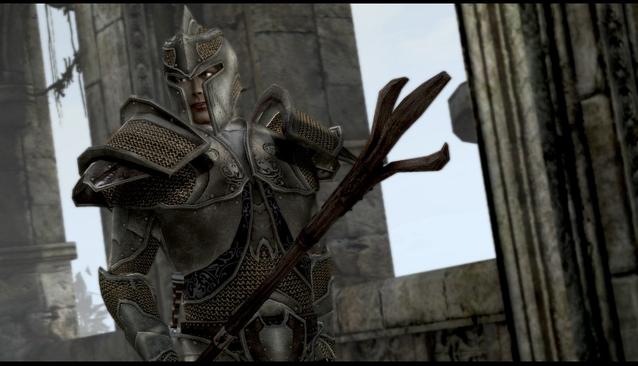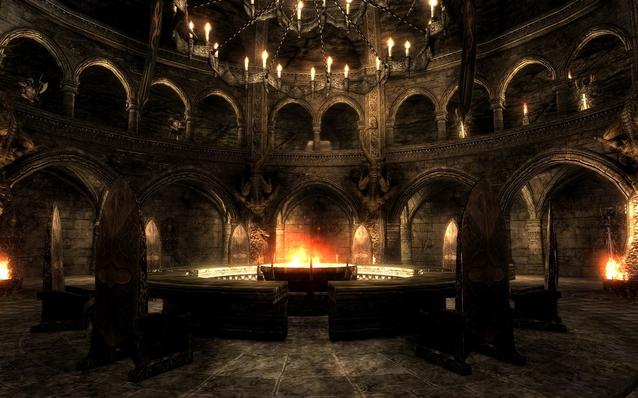Meta:Two Worlds II - Interview
This Q&A was posted to the website ugdb by Trochilus on August 24, 2010.[1]
Questions and Answers[edit | edit source]
In 2007, Reality Pump successfully delivered a game in which players had a real chance to shape the world with their actions, with a strong and non-liner story and some really impressive combat sequences. Now, just a couple of weeks before the release of Two Worlds II, we still have a lot of questions to ask the developers and Jake DiGennaro, the PR & Community Director for TopWare Interactive is ready to answer them all.
UGDB: Please, introduce yourself briefly – what is your current job position, your professional experience in the game industry, etc.?
Jake DiGennaro: I'm Jake DiGennaro, and my official position is the PR & Community Director for TopWare Interactive, however being a small independent company we all wear a number of different hats. So while I might be found demoing at a trade show one day, I may be halfway across the world in Poland the next working with our developers at on gameplay mechanics. It's a dream job really.
UGDB: We already know that you’ve disbanded the original writing team of Two Worlds, but it was never revealed as to why. They’ve created the entire Antaloor universe, right? What went wrong with the original team and what can you tell us about the new writing team?
Jake DiGennaro: It wasn't that we disbanded the team, rather we restructured the nature of how they operate. The first time around Reality Pump did a great job creating an engaging fantasy world, but when it came time to localize the text and dialogue into different languages, including English, those responsibilities were largely outsourced to partners who, while talented, weren't intimately involved in the creation or development of Antaloor. With Two Worlds II we've taken extensive care to develop a multinational collaborative team who have worked together from the outset to ensure the game's narrative foundation is designed as the cornerstone of the experience.
UGDB: The original Two Worlds did not receive the best of critic reviews. What were the main problems with the first game in your opinion and how have you managed to improve them successfully in the sequel?
Jake DiGennaro: I think it really came down to us biting off a bit more than we could chew the first go-round. We'd never developed an RPG, an open world game, or even a console title for that matter, and you have to keep in mind the team responsible for Two Worlds was only about 30 people, minuscule compared to the teams sometimes upwards of 150+ working on similar titles. The result was a lot of growing pains, unexpected obstacles, and aspects of the game which didn't end up playing out the way we had imagined them on paper when the project first got off the ground. The good thing that came of that that experience was, well experience. We were much more prepared for what we were up against during the development of Two Worlds II, and being able to has so much of that pressure alleviated has given us much more time to refine, hone, and polish the game as opposed to simply finding solutions to problems.
UGDB: It is known that you’ve completely redesigned the whole combat system, which is now more sophisticated. So, how exactly has the combat changed?
Jake DiGennaro: The overall flow and much more natural feel of the combat system is the biggest improvement. The stiffness associated with the combat in the original Two Worlds has been eased, and we've added some new mechanics such as an active block system and basic counter attacks.
UGDB: Two Worlds has a not so ordinary RPG progression system, a classless-based system. In our opinion, it is more flexible than the class-driven system found in most other RPGs, because there is no limitation to certain playing types. You’ve kept this model for Two Worlds II, but how has it evolved and can you give us some examples of the progression?
Jake DiGennaro: One of our biggest goals with the game as a whole was to try and offer as much flexibility as we could within the constraints of the experience as a whole. One of the means to that end is the character advancement system, which allows players to pick and choose which specific abilities they want their character to specialize in, and then weave the execution of these skills into a play style suited specifically for them. Want to be the traditional bit stalky warrior that swings a huge hammer? Fine, go for it. Perhaps instead you'd like to combine crowd controlling ranged bow skills with debuffing magic, focus on duel wielding weapons for close combat, and add in a splash of explosive trap fabrication just for kicks? More power to you. Our job is to lay it out there, and it's up to the player to decide how to take advantage of the options.
UGDB: This time around there will be a “CRAFT” system, with the possibility of creating your own weapons and armor. How will the system work and will it be possible [for example] for the player to make some IMBA equipment with lots of effort?
Jake DiGennaro: The CRAFT feature doesn't allow you to actually create new items, but rather build upon what you already have. By breaking down various pieces of equipment collected during the journey players will accumulate raw materials such as wood, steel, leather, etc. Using these materials they can upgrade other pieces of equipment improving their statistics, and opening socket slots which can be filed with various enhancement crystals further augmenting stats or giving the equipment special characteristics (i.e. weapon with bonus fire damage). In this way there is a reason to collect equipment from defeated enemies other than just for vendor loot or that hand-me-down armor shop you were planning on opening in the town square.
UGDB: We remember that in the first game, faction affiliations was a bit limited, but were interesting in many ways. How have they evolved in the sequel and can you give us some examples of such?
Jake DiGennaro: Faction ratings plays an important role in which quests will become available to the player, how various NPCs perceive the hero, and to a degree even the way the player will experience certain elements of the primary narrative. Align yourself with the Merchants Guild for instance, and while you may get a few bucks off purchases and access to some amazing "back room inventory" items not otherwise available, some groups in the game might begin to see you as a profit hungry snake who would gladly sell them out in exchange for a sack of gold.
UGDB: You’ve developed a brand new engine for Two Worlds II called GRACE, allowing richer and deeper environments with a lot of neat looking textures and lighting. Tell us more about the technical aspect of the game? Will it have a weather system, and DirectX 10/11 support, for example?
Jake DiGennaro: The GRACE engine is obviously the backbone of the entire Two Worlds II project, designed in-house by Reality Pump specifically for this game. It's allowed the team to really show off some of its biggest strengths with regards to creating the gorgeous landscape of Antaloor. Additionally it has alleviated a lot of our issues with regards to development on the consoles, allowing us to work on all 3 versions of the game (PC, Xbox 360, and PlaySation 3) simultaneously instead of developing for a lead platform and simply porting the game. Players will experience weather patterns during the adventures, as well as some unique effects of the day/night cycle, and find the environments very responsive to their presence. Rest assured the game will be feature compatibility with DirectX 9/10/11.
UGDB: Can you share with us some stats around the development of Two Worlds II – for example, from how long has the game been in production; how many different weapons and items are there in the Two Worlds II; how many quests were in the original game in comparison to Two Worlds II; how big is the world compared to the first game; how much time we’ll need to complete the game following only the main storyline and how much time we’ll need to finish it doing all side quests?
Jake DiGennaro: The game has been in production is some form or another for roughly 3 years now, there are well over 100 different weapons alone to collect or break down, we've bolstered the number of side-quests pretty significantly and added much more depth to them opposed to mostly kill/collect quests, the game world is about 60 square kilometers in total which is roughly 30% bigger than the original, and the game will take approximately 25 hours to complete from point A to B, with another 20 hours or so of side questing, plus all the multiplayer content including a co-op campaign, PvP, and "Village Mode".
Сайт UGDB.com взял интервью у Jake’a DiGennaro.[edit | edit source]
This translation was posted to the website twoworld2.ru by DV on August 25, 2010.[2]
Сайт UGDB взял интервью у PR менеджера TopWare Jake’a DiGennaro , я же, перевел его для вас.
UGDB: Мы уже знаем, что вы распустили первоначальный состав писателей Two Worlds, но не когда не рассказывали, почему. Они создали всю вселенную Анталоора, верно? Так, что случилось с той командой, и что вы можете рассказать нам о новой команде писателей?
Jake DiGennaro: Не то, чтобы мы распустили команду,скорее мы перестроили принцип, по которому они работают. В первый раз Reality Pump проделали большую работу по созданию приключений в мире фантази, но когда пришло время, локализовать текст и диалоги на различные языки, включая английский, эти задачи были переданы партнерам, которые,хоть и были талантливы, но они не принимали непосредственного участия в создании и развитии Анталоора. В Two Worlds II мы разработали совместные многонациональные команды, которые работают вместе с самого начала — обеспечивая описательную основу игры.
UGDB: Two Worlds не был «обласкан» критиками. Какие были проблемы, у первой игры, по вашему мнению, и как Вам удалось избежать их в дальнейшем?
Jake DiGennaro: Я думаю, «мы действительно взвалили на себя больше, чем могли унести»- когда работали над 1ой игрой. Мы никогда не разрабатывали RPG с открытым миром, и проекты для консолей, впрочем, вы должны иметь в виду ,что команда отвечающая за Two Worlds была лишь где то 30 человек, это мало по сравнению с командами(которые работают над играми такого масштаба) численность которых иногда достигает свыше 150 + . В результате многие ошибки связанные с размером игры, неожиданные проблемы, а также аспекты игры, которые не были доведены до ума,и работали не так, как мы себе представляли их на бумаге — когда мы только начинали работать. Я рад что все так сложилось, в замен , мы получили опыт, хороший опыт надо сказать. Мы были гораздо более подготовлены ,потому что «мы выросли» ко времени разработки Two Worlds II, и у нас было гораздо больше времени, чтобы уточнять, оттачивать и шлифовать игру - заместо того что бы просто выискивать нерешенные проблемы.
UGDB: Известно, что вы полностью переработали боевую систему, которая стала более продуманна. Итак, как же именно имеет она изменилась?
Jake DiGennaro: Гораздо более естественный вид боевой системы является крупнейшим улучшением. Чопорность боевой системой из Two Worlds осталась в прошлом, и мы разработали абсолютно новую механику. Она включает в себя активную систему блоков, и контр атак.
UGDB: Two Worlds имеет не совсем обычную RPG систему, бесклассового развития. На наш взгляд, она является более гибкой, чем классовая система, употребляемая в большинстве других RPG.Вы сохранили эту модель в Two Worlds II, но как она усовершенствовалась и можете ли вы дать нам несколько примеров этих усовершенствований ?
Jake DiGennaro: Одной из наших крупнейших задач при создании игры , было создание большой «гибкости».Одним из средств достижения этой цели — является система развития персонажа, которая позволяет игрокам выбирать, в какой именно области(областях) их персонаж будет специализироваться. Хотите быть воином , который машет огромным молотом? Не вопрос, идите по этому пути. Может быть, вы хотите быть лучником и при этом владеть магией , сосредоточиться на поединке с двумя оружиями ближнего боя, и готовить взрывные ловушки? У вас есть много возможностей. Наша работа заключается в реализации этих возможностей так — что бы у игрока был выбор, как воспользоваться преимуществами нашей системы.
UGDB: На этот раз будет система крафтинга, с возможностью создания собственного оружия и брони. Как система эта систем работает ?
Jake DiGennaro: Система крафтинга не позволяет создавать новые элементы, а строится на том, что у вас уже есть. Разбивая различные виды экипировки, во время путешествия игроки будут находить сырье, такое как дерево, сталь, кожа и т.д. Используя эти материалы — можно улучшить некоторые вещи из экипировки, повысить их показатели, и открыть дополнительные слоты — которые могут быть заполнены различными кристаллами, которые в свою очередь увеличат показатели предмета, или предоставят ему специфические способности (например, для оружие, это может быть — урон огнем). Таким образом, есть смысл для сбора экипировки с поверженных врагов, не только для того что бы продавать ее магазине.
UGDB: Мы помним, что в первой игре, принадлежность к гильдиям была несколько ограничена. Какое развитие этот аспект получил в TW2 ?
Jake DiGennaro: Фракция играет важную роль в доступности определенных квестов для игрока,а так же влияют на отношения различных нпс к герою , и в определенной степени, даже на некоторые элементы основного повествования. Начните работать с гильдией купцов, например, и вы получите скидки при покупке экипировки , и доступ к некоторым удивительным вещам (в скрытом разделе магазинов),некоторые гильдии в игре,могут начать относиться к вам как к «продажной голодной змее«, которая охотно продаст их в обмен на мешок с золотом.
UGDB: Вы разработали новый движок для Two Worlds II под названием GRACE. Расскажите нам больше о техническом аспекте игры? Будет ли система погоды и поддержка DirectX 10/11?
Jake DiGennaro: Движок GRACE является основой Two Worlds II , разработанный Reality Pump специально для этой игры . Это позволило создать действительно великолепный ландшафт Анталоора . Кроме того он устранил многие наши проблемы в отношении разработки игры на консолях, он позволяет нам работать по всем 3ем версиям игры (PC, Xbox 360 и PlaySation 3) одновременно — вместо разработки для одной платформы, и последующего переноса игры на другие. Мы сделали достаточно реалистичные погодные условия, а также некоторые уникальные эффекты цикла дня/ночи, и конечно окружающая среда будет реагировать на ваше присутствия. И могу вас уверить, что игра будет поддерживать совместимость с DirectX 9/10/11.
